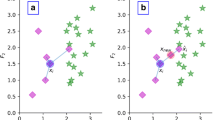Abstract
An imbalanced data set creates severe problems for the classifier as number of samples of one class (majority) is much higher than the other class (minority). Synthetic oversampling methods address this problem by generating new synthetic minority class samples. To distribute the synthetic samples effectively, recent approaches create weight values for original minority samples based on their importance and distribute synthetic samples according to weight values. However, most of the existing algorithms create inappropriate weights and in many cases, they cannot generate the required weight values for the minority samples. This results in a poor distribution of generated synthetic samples. In this respect, this paper presents a new synthetic oversampling algorithm, Proximity Weighted Synthetic Oversampling Technique (ProWSyn). Our proposed algorithm generate effective weight values for the minority data samples based on sample’s proximity information, i.e., distance from boundary which results in a proper distribution of generated synthetic samples across the minority data set. Simulation results on some real world datasets shows the effectiveness of the proposed method showing improvements in various assessment metrics such as AUC, F-measure, and G-mean.
Access this chapter
Tax calculation will be finalised at checkout
Purchases are for personal use only
Preview
Unable to display preview. Download preview PDF.
Similar content being viewed by others
References
Weiss, G.M.: Mining with Rarity: A Unifying Framework. ACM SIGKDD Explorations Newsletter 6(1), 7–19 (2004)
Holte, R.C., Acker, L., Porter, B.W.: Concept Learning and the Problem of Small Disjuncts. In: Proc. Int’l J. Conf. Artificial Intelligence, pp. 813–818 (1989)
Quinlan, J.R.: Induction of Decision Trees. Machine Learning 1(1), 81–106 (1986)
Murphy, P.M., Aha, D.W.: UCI repository of Machine learning databases. University of California Irvine, Department of Information and Computer Science
Lewis, D., Catlett, J.: Heterogeneous Uncertainty Sampling for Supervised Learning. In: Proc. of the Eleventh International Conference of Machine Learning, pp. 148–156 (1994)
Fawcett, T.E., Provost, F.: Adaptive Fraud Detection. Data Mining and Knowledge Discovery 3(1), 291–316 (1997)
Kubat, M., Holte, R.C., Matwin, S.: Machine Learning for the Detection of Oil Spills in Satellite Radar Images. Machine Learning 30(2/3), 195–215 (1998)
Ling, C.X., Li, C.: Data Mining for Direct Marketing: Problems and Solutions. In: Proc. Int’l Conf. on Knowledge Discovery & Data Mining (1998)
Japkowicz, N., Myers, C., Gluck, M.: A Novelty Detection Approach to Classification. In: Proc. of the Fourteenth International Joint Conference on Artificial Intelligence, pp. 518–523 (1995)
He, H., Garcia, E.A.: Learning from imbalanced data. IEEE Trans. Knowl. Data Eng. 21(10), 1263–1284 (2009)
Liu, X.Y., Wu, J., Zhou, Z.H.: Exploratory Under Sampling for Class Imbalance Learning. In: Proc. Int’l Conf. Data Mining, pp. 965–969 (2006)
Zhang, J., Mani, I.: KNN Approach to Unbalanced Data Distributions: A Case Study Involving Information Extraction. In: Proc. Int’l Conf. Machine Learning, ICML 2003, Workshop Learning from Imbalanced Data Sets (2003)
Kubat, M., Matwin, S.: Addressing the Curse of Imbalanced Training Sets: One-Sided Selection. In: Proc. Int’l Conf. Machine Learning, pp. 179–186 (1997)
Batista, G.E.A.P.A., Prati, R.C., Monard, M.C.: A Study of the Behavior of Several Methods for Balancing Machine Learning Training Data. ACM SIGKDD Explorations Newsletter 6(1), 20–29 (2004)
Chawla, N.V., Bowyer, K.W., Hall, L.O., Kegelmeyer, W.P.: SMOTE: Synthetic Minority Over-Sampling Technique. J. Artificial Intelligence Research 16, 321–357 (2002)
Cieslak, D.A., Chawla, N.V.: Start Globally, Optimize Locally, Predict Globally: Improving Performance on Imbalanced Data. In: Proc. IEEE Int’l Conf. Data Mining, pp. 143–152 (2008)
He, H., Bai, Y., Garcia, E.A., Li, S.: ADASYN: Adaptive Synthetic Sampling Approach for Imbalanced Learning. In: Proc. Int’l J. Conf. Neural Networks, pp. 1322–1328 (2008)
Chen, S., He, H., Garcia, E.A.: RAMOBoost: Ranked Minority Oversampling in Boosting. IEEE Trans. Neural Networks 21(20), 1624–1642 (2010)
Barua, S., Islam, M. M., Murase, K.: A Novel Synthetic Minority Oversampling Technique for Imbalanced Data Set Learning. In: Lu, B.-L., Zhang, L., Kwok, J. (eds.) ICONIP 2011, Part II. LNCS, vol. 7063, pp. 735–744. Springer, Heidelberg (2011)
Japkowicz, N., Stephen, S.: The Class Imbalance Problem: A Systematic Study. Intelligent Data Analysis 6(5), 429–449 (2000)
Quinlan, J.R.: C4.5: programs for machine learning. Morgan Kaufmann, San Francisco (1993)
UCI Machine Learning Repository, http://archive.ics.uci.edu/ml/
Fawcett, T.: ROC Graphs: Notes and Practical Considerations for Data Mining Researchers. Technical Report HPL-2003-4, HP Labs (2003)
Corder, G.W., Foreman, D.I.: Nonparametric Statistics for Non-Statisticians: A step-by-Step Approach. Wiley, New York (2009)
Critical Value Table of Wilcoxon Signed-Ranks Test, http://www.sussex.ac.uk/Users/grahamh/RM1web/WilcoxonTable2005.pdf
Author information
Authors and Affiliations
Editor information
Editors and Affiliations
Rights and permissions
Copyright information
© 2013 Springer-Verlag Berlin Heidelberg
About this paper
Cite this paper
Barua, S., Islam, M.M., Murase, K. (2013). ProWSyn: Proximity Weighted Synthetic Oversampling Technique for Imbalanced Data Set Learning. In: Pei, J., Tseng, V.S., Cao, L., Motoda, H., Xu, G. (eds) Advances in Knowledge Discovery and Data Mining. PAKDD 2013. Lecture Notes in Computer Science(), vol 7819. Springer, Berlin, Heidelberg. https://doi.org/10.1007/978-3-642-37456-2_27
Download citation
DOI: https://doi.org/10.1007/978-3-642-37456-2_27
Publisher Name: Springer, Berlin, Heidelberg
Print ISBN: 978-3-642-37455-5
Online ISBN: 978-3-642-37456-2
eBook Packages: Computer ScienceComputer Science (R0)




